The Impacts of Vegetation and Meteorological Factors on Aerodynamic Roughness Length at Different Time Scales
Abstract
1. Introduction
2. Data and Study Area
2.1. Site Description
2.2. Data
2.2.1. Onsite Data
2.2.2. Satellite Data
3. Methods
3.1. Calculation of the Obukhov Length L
3.2. Calculating the Aerodynamic Roughness Length from AWS Data
3.3. Correlation Analysis
3.4. Factor Analysis
4. Results
4.1. Driving Factors for Changes in Half-Hourly and Daily z0m
4.2. Contributions of Driving Factors to Half-Hourly z0m
4.3. Contributions of Driving Factors to Daily z0m
5. Discussion
5.1. The Applicability of Monin–Obukhov Similarity
5.2. The Wind Speed Factor
5.3. The Wind Direction Factor
5.4. The Atmospheric Stability Factor
6. Conclusions
Acknowledgments
Author Contributions
Conflicts of Interest
References
- Stull, R.B. An Introduction to Boundary Layer Meteorology. Atmos. Sci. Libr. 1988, 8, 89. [Google Scholar]
- Hryama, T.; Sugita, M.; Kotoda, K. Regional Roughness Parameters and Momentum Fluxes over a Complex Area. J. Appl. Meteorol. 1996, 35, 336–347. [Google Scholar] [CrossRef]
- Marticorena, B.; Kardous, M.; Bergametti, G.; Callot, Y.; Chazette, P.; Khatteli, H.; Le Hégarat-Mascle, S.; Maillé, M.; Rajot, J.; Vidal-Madjar, D.; et al. Surface and aerodynamic roughness in arid and semiarid areas and their relation to radar backscatter coefficient. J. Geophys. Res. Earth Surf. 2006, 111. [Google Scholar] [CrossRef]
- Monteith, J.L. The micrometeorology of crops. In Principles of Environmental Physics; Edward Arnold: London, UK, 1973; pp. 190–215. [Google Scholar]
- Brutsaert, W. Evaporation into the Atmosphere; Theory, History, and Applications; Springer: Dordrecht, The Netherlands, 1982. [Google Scholar]
- Raupach, M.R. Drag and drag partition on rough surfaces. Bound. Layer Meteorol. 1992, 60, 375–395. [Google Scholar] [CrossRef]
- Raupach, M. Simplified expressions for vegetation roughness length and zero-plane displacementas functions of canopy height and area index. Bound. Layer Meteorol. 1994, 71, 211–216. [Google Scholar] [CrossRef]
- Schmid, H.P.; Bünzli, B. The influence of surface texture on the effective roughness length. Q. J. R. Meteorol. Soc. 1995, 121, 1–21. [Google Scholar] [CrossRef]
- Gupta, R.K.; Prasad, T.S.; Vijayan, D. Estimation of roughness length and sensible heat flux from WiFS and NOAA AVHRR data. Adv. Sp. Res. 2002, 29, 33–38. [Google Scholar] [CrossRef]
- Choudhury, B.J.; Monteith, J.L. A four-layer model for the heat budget of homogeneous land surfaces. Q. J. R. Meteorol. Soc. 1988, 114, 373–398. [Google Scholar] [CrossRef]
- Yu, M.; Wu, B.; Yan, N.; Xing, Q.; Zhu, W. A Method for Estimating the Aerodynamic Roughness Length with NDVI and BRDF Signatures Using Multi-Temporal Proba-V Data. Remote Sens. 2016, 9, 6. [Google Scholar] [CrossRef]
- Colin, J.; Menenti, M.; Rubio, E.; Jochum, A. Accuracy vs. Operability: A Case Study over Barrax in the Context of the DEMETER Project. AIP Conf. Proc. 2006, 852, 75–83. [Google Scholar]
- Jasinski, M.F.; Borak, J.; Crago, R. Bulk surface momentum parameters for satellite-derived vegetation fields. Agric. For. Meteorol. 2005, 133, 55–68. [Google Scholar] [CrossRef]
- Zhou, Y.L.; Sun, X.M.; Zhang, R.H.; Zhu, Z.L.; Xu, J.P.; Li, Z.L. The improvement and validation of the model for retrieving the effective roughness length on TM pixel scale. In Proceedings of the IEEE International Geoscience and Remote Sensing Symposium, Seoul, Korea, 25–29 July 2005; pp. 3059–3062. [Google Scholar]
- Zhou, Y.L. Surface Roughness Length Dynamic and Its Effects on Fluxes Simulation. Ph.D. Thesis, Institute of Geographic Sciences and Natural Resources Research, CAS, Beijing, China, 2008. [Google Scholar]
- Gao, Y.; Hu, Y. Advances in HEIFE Research (1987–1994); China Meteorological Press: Beijing, China, 1994. [Google Scholar]
- Li, X.; Li, X.W.; Li, Z.; Ma, M.; Wang, J.; Xiao, Q.; Liu, Q.; Che, T.; Chen, E.; Yan, G.; et al. Watershed allied telemetry experimental research. J. Geophys. Res. Atmos. 2009, 114, 2191–2196. [Google Scholar] [CrossRef]
- Liu, X.; Cheng, G.D.; Liu, S.M.; Xiao, Q.; Ma, M.; Jin, R.; Che, T.; Liu, Q.; Wang, W.; Qi, Y.; et al. Heihe watershed allied telemetry experimental research (Hiwater): Scientific objectives and experimental design. Bull. Am. Meteorol. Soc. 2013, 94, 1145–1160. [Google Scholar] [CrossRef]
- Mingguo, M.; Weizhen, W.; Junlei, T.; Guanghui, H.; Zhihui, Z. WATER: Dataset of Automatic Meteorological Observations at the Dayekou Guantan Forest Station in the Dayekou Watershed; Cold and Arid Regions Environmental and Engineering Research Institute, Chinese Academy of Sciences: Beijing, China, 2008. [Google Scholar]
- Liu, S.M.; Xu, Z.W.; Wang, W.Z.; Jia, Z.Z.; Zhu, M.J.; Bai, J.; Wang, J.M. A comparison of eddy-covariance and large aperture scintillometer measurements with respect to the energy balance closure problem. Hydrol. Earth Syst. Sci. 2011, 15, 1291–1306. [Google Scholar] [CrossRef]
- Chen, J.; Jönsson, P.; Tamura, M.; Gu, Z.; Matsushita, B.; Eklundh, L. A simple method for reconstructing a high-quality NDVI time-series data set based on the Savitzky-Golay filter. Remote Sens. Environ. 2004, 91, 332–344. [Google Scholar] [CrossRef]
- Yin, G.; Li, J.; Liu, Q.; Fan, W.; Xu, B.; Zeng, Y.; Zhao, J. Regional Leaf Area Index Retrieval Based on Remote Sensing: The Role of Radiative Transfer Model Selection. Remote Sens. 2015, 7, 4604–4625. [Google Scholar] [CrossRef]
- Yin, G.; Li, J.; Liu, Q.; Zhong, B.; Li, A. Improving LAI spatio-temporal continuity using a combination of MODIS and MERSI data. Remote Sens. Lett. 2016, 7, 771–780. [Google Scholar] [CrossRef]
- Li, X.; Liu, S.M.; Xiao, Q.; Ma, M.G.; Jin, R.; Che, T.; Wang, W.Z.; Hu, X.L.; Xu, Z.W.; Wen, J.G.; et al. A multiscale dataset for understanding complex eco-hydrological processes in a heterogeneous oasis system. Sci. Data 2017, 4, 170083. [Google Scholar] [CrossRef] [PubMed]
- Argyle, P.; Watson, S.J. Assessing the dependence of surface layer atmospheric stability on measurement height at offshore locations. J. Wind Eng. Ind. Aerodyn. 2014, 131, 88–99. [Google Scholar] [CrossRef]
- Richardson, L.F. Some Measurements of Atmospheric Turbulence. R. Soc. 1921, 221, 582–593. [Google Scholar] [CrossRef]
- Zhu, W.; Wu, B.; Yan, N.; Feng, X.; Xing, Q. A method to estimate diurnal surface soil heat flux from MODIS data for a sparse vegetation and bare soil. J. Hydrol. 2014, 511, 139–150. [Google Scholar] [CrossRef]
- Panofsky, H.A. Determination of stress from wind and temperature measurement. Q. J. R. Meteorol. Soc. 1963, 89, 85–94. [Google Scholar] [CrossRef]
- Dyer, A.J. A review of flux-profile relationships. Bound. Layer Meteorol. 1974, 7, 363–372. [Google Scholar] [CrossRef]
- Webb, E.K. Profile relationships: The log-linear range, and extension to strong stability. Q. J. R. Meteorol. Soc. 1970, 96, 67–90. [Google Scholar] [CrossRef]
- Frangi, J.P.; Richard, D.C. The WELSONS experiment: Overview and presentation of first results on the surface atmospheric boundary-layer in semiarid Spain. Ann. Geophys. 2000, 18, 365–384. [Google Scholar] [CrossRef]
- Zhou, Y.; Ju, W.; Sun, X.; Wen, X.; Guan, D. Significant decrease of uncertainties in sensible heat flux simulation using temporally variable aerodynamic roughness in two typical forest ecosystems of China. J. Appl. Meteorol. Climatol. 2012, 51, 1099–1110. [Google Scholar] [CrossRef]
- Pielke, S.; Roger, A. Mesoscale Meteorological Modeling; Academic Press: Cambridge, MA, USA, 2013; Volume 98. [Google Scholar]
- Zou, M.; Niu, J.; Kang, S.; Li, X.; Lu, S. The contribution of human agricultural activities to increasing evapotranspiration is significantly greater than climate change effect over Heihe agricultural region. Sci. Rep. 2017, 7, 8805. [Google Scholar] [CrossRef] [PubMed]
- Kaiser, H.F. An index of factorial simplicity. Psychometrika 1974, 39, 31–36. [Google Scholar] [CrossRef]
- Bartlett, M.S. Properties of Sufficiency and Statistical Tests. Proc. R. Soc. Lond. 1937, 160, 268–282. [Google Scholar] [CrossRef]
- Motta, M.; Barthelmie, R.J.; Vølund, P. The influence of non-logarithmic wind speed profiles on potential power output at Danish offshore sites. Wind Energy 2005, 8, 219–236. [Google Scholar] [CrossRef]
- Muñozesparza, D.; Cañadillas, B.; Neumann, T.; van Beeck, J. Turbulent fluxes, stability and shear in the offshore environment: Mesoscale modelling and field observations at FINO1. J. Renew. Sustain. Energy 2012, 4, 063136. [Google Scholar] [CrossRef]
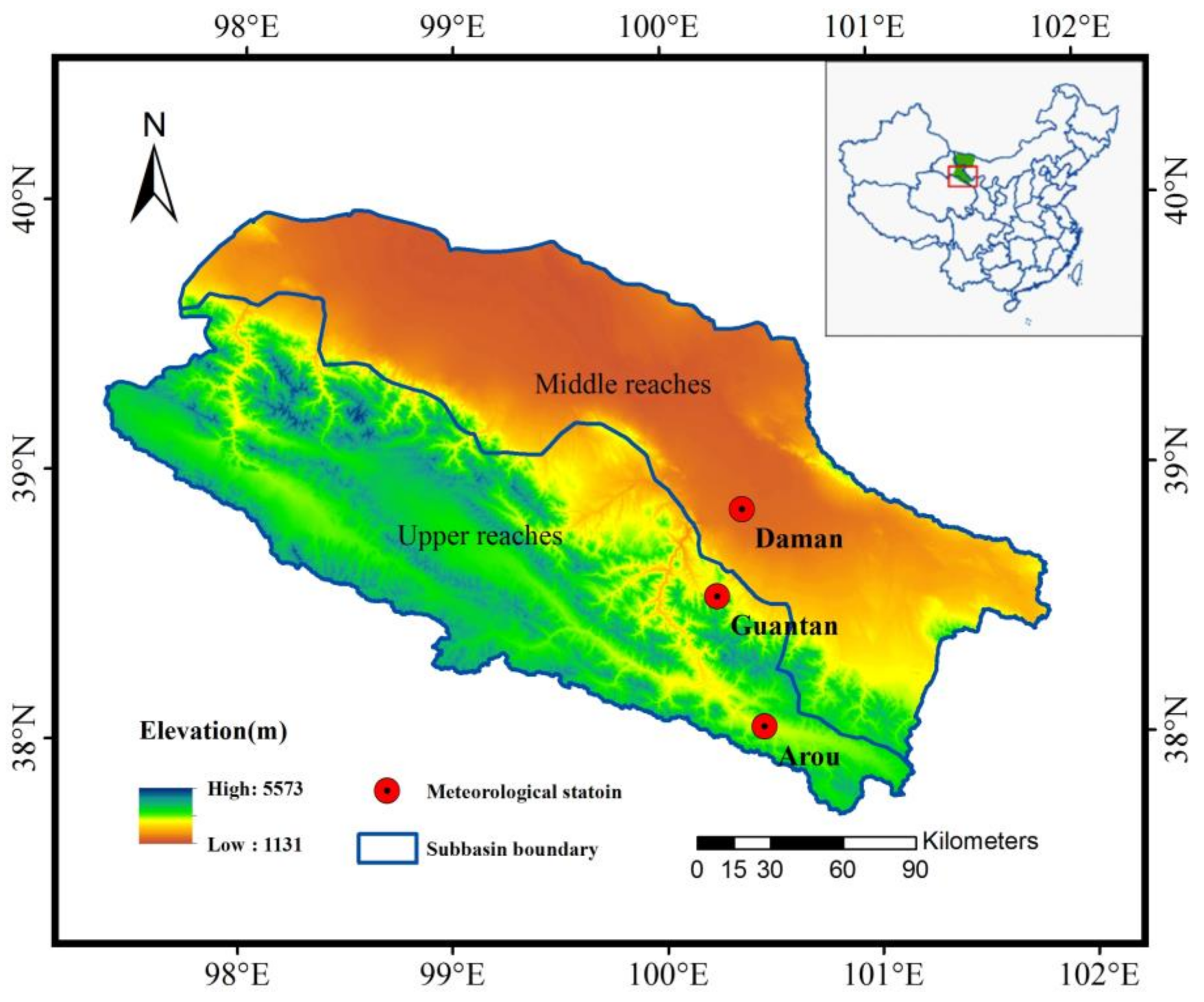
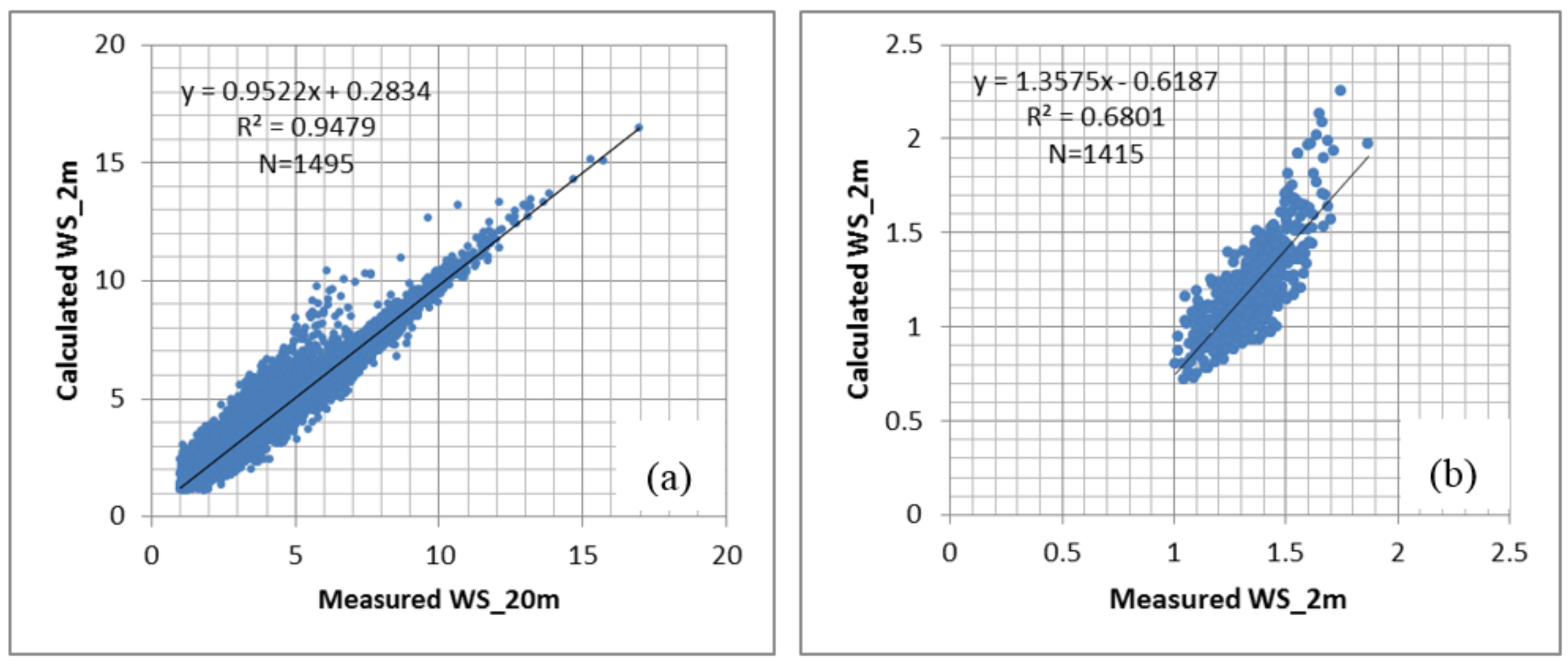

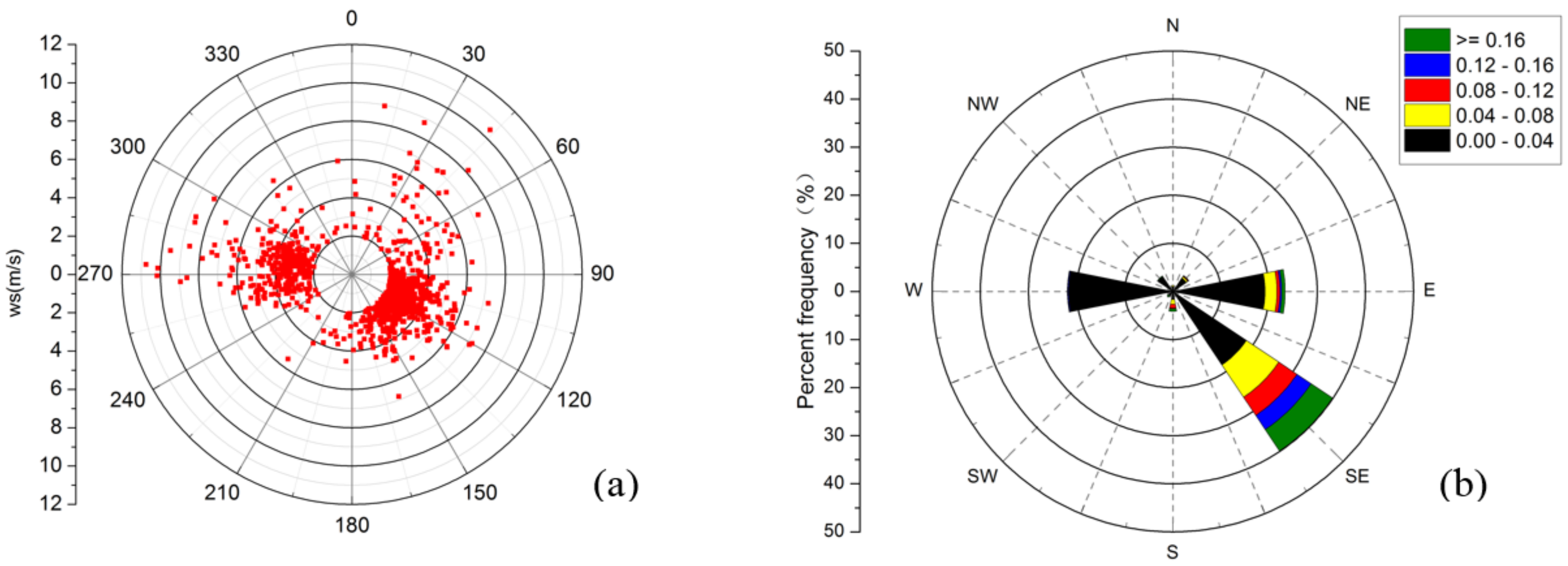

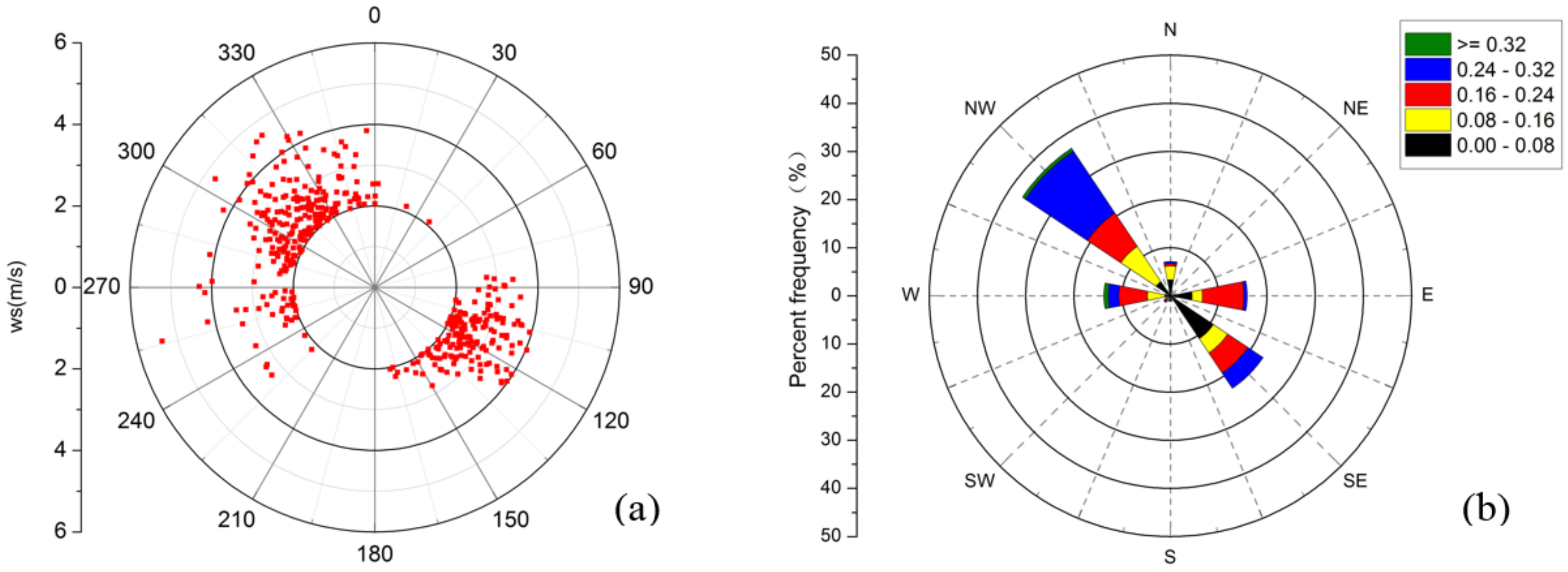

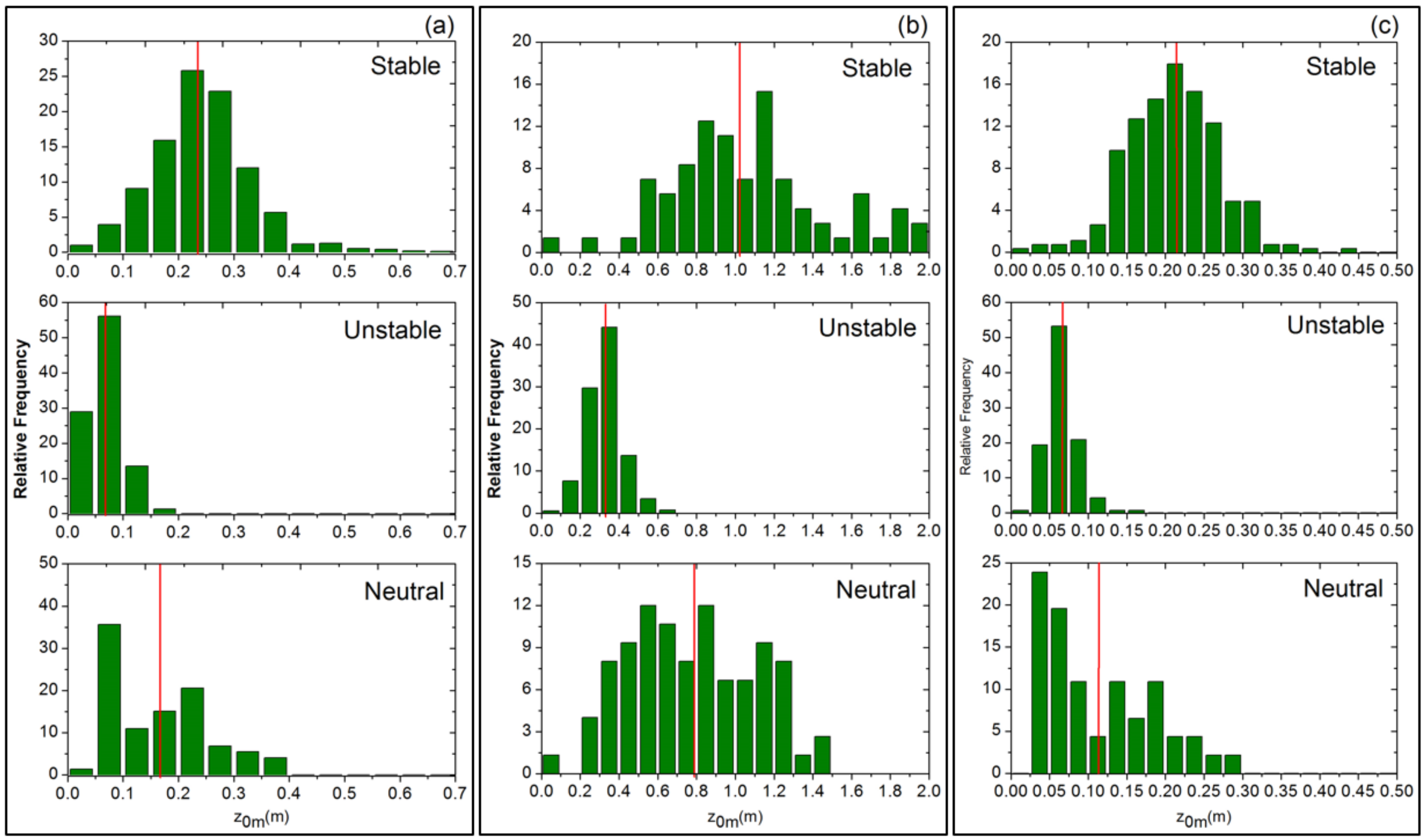
| Location | Coordinates | Altitude (m) | Land Use | Sensor Height (m) | Period | Data Logger |
|---|---|---|---|---|---|---|
| Arou | 38°2′50′′ N, 100°27′51′′ E | 3033 | Alpine meadow | 1, 2, 5, 10, 15, 25 | 1 May 2014–31 October 2014 | CR23X |
| Guantan | 38°32′1′′ N, 100°15′0′′ E | 2835 | Qinghai spruce | 2, 10, 24 | 1 May 2011–31 October 2011 | CR23XTD |
| Daman | 38°51′20′′ N, 100°22′20′′ E | 1556 | Spring maize | 3, 5, 10, 15, 20, 30, 40 | 1 May 2014–31 October 2014 | CR800 |
| Factors | Arou z0m | Guantan z0m | Daman z0m | |||
|---|---|---|---|---|---|---|
| Half-Hourly | Daily | Half-Hourly | Daily | Half-Hourly | Daily | |
| WS | −0.592 ** | −0.488 ** | −0.409 ** | −0.326 * | −0.326 * | −0.345 * |
| 0.574 ** | 0.641 ** | 0.725 ** | 0.407 ** | 0.027 | 0.123 | |
| RH | 0.274 | 0.040 | 0.137 | 0.093 | 0.011 | 0.061 |
| T | −0.125 | −0.200 | 0.223 | 0.180 | 0.149 | 0.263 |
| L | 0.608 ** | - | 0.602 ** | - | 0.542 ** | - |
| P | 0.113 | 0.079 | 0.276 | 0.151 | 0.009 | 0.056 |
| NDVI | 0.161 | 0.282 | 0.018 | 0.130 | 0.546 ** | 0.639 ** |
| LAI | 0.081 | 0.177 | −0.069 | 0.052 | 0.571 ** | 0.671 ** |
| Factors | Arou Half-Hourly | Guantan Half-Hourly | Daman Half-Hourly | Daman Daily | ||||
|---|---|---|---|---|---|---|---|---|
| A_Factor | T_Factor | A_Factor | T_Factor | V_Factor | A_Factor | V_Factor | A_Factor | |
| WS | −0.765 | −0.003 | −0.799 | −0.232 | −0.239 | −0.514 | −0.350 | −0.667 |
| −0.042 | 0.998 | −0.026 | 0.829 | - | - | - | - | |
| L | 0.764 | −0.052 | 0.662 | 0.095 | 0.010 | 0.973 | - | - |
| NDVI | - | - | - | - | 0.959 | −0.068 | 0.969 | −0.023 |
| LAI | - | - | - | - | 0.941 | −0.058 | 0.960 | −0.047 |
| Site | Items | Component | Rotation Sums of Squared Loadings | ||
|---|---|---|---|---|---|
| Eigen Value | Variance Contribution (%) | Cumulative Variance Contribution (%) | |||
| Arou | Half-hourly z0m | A_factor | 1.971 | 44.03 | 44.03 |
| T_factor | 1.202 | 38.33 | 82.36 | ||
| Guantan | Half-hourly z0m | A_factor | 1.706 | 42.87 | 42.87 |
| T_factor | 1.280 | 38.66 | 81.53 | ||
| Daman | Half-hourly z0m | V_factor | 2.125 | 53.14 | 53.14 |
| A_factor | 1.052 | 30.29 | 83.43 | ||
| Daily z0m | V_factor | 2.178 | 54.46 | 54.46 | |
| A_factor | 1.057 | 30.67 | 85.13 | ||
| Arou | Guantan | Daman | |
|---|---|---|---|
| primary wind direction | 0.072(SE) | 0.349(SE) | 0.237(NW) |
| secondary wind direction | 0.009(W) | 1.021(NW) | 0.215(SE) |
| Atmospheric Condition | Definition |
|---|---|
| Stable | 0 < L < 1000 |
| Unstable | −1000 < L < 0 |
| Neutral | L < −1000 or L > 1000 |
© 2018 by the authors. Licensee MDPI, Basel, Switzerland. This article is an open access article distributed under the terms and conditions of the Creative Commons Attribution (CC BY) license (http://creativecommons.org/licenses/by/4.0/).
Share and Cite
Yu, M.; Wu, B.; Zeng, H.; Xing, Q.; Zhu, W. The Impacts of Vegetation and Meteorological Factors on Aerodynamic Roughness Length at Different Time Scales. Atmosphere 2018, 9, 149. https://doi.org/10.3390/atmos9040149
Yu M, Wu B, Zeng H, Xing Q, Zhu W. The Impacts of Vegetation and Meteorological Factors on Aerodynamic Roughness Length at Different Time Scales. Atmosphere. 2018; 9(4):149. https://doi.org/10.3390/atmos9040149
Chicago/Turabian StyleYu, Mingzhao, Bingfang Wu, Hongwei Zeng, Qiang Xing, and Weiwei Zhu. 2018. "The Impacts of Vegetation and Meteorological Factors on Aerodynamic Roughness Length at Different Time Scales" Atmosphere 9, no. 4: 149. https://doi.org/10.3390/atmos9040149
APA StyleYu, M., Wu, B., Zeng, H., Xing, Q., & Zhu, W. (2018). The Impacts of Vegetation and Meteorological Factors on Aerodynamic Roughness Length at Different Time Scales. Atmosphere, 9(4), 149. https://doi.org/10.3390/atmos9040149






